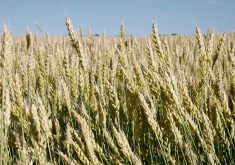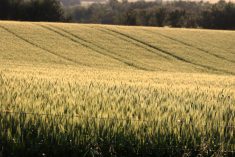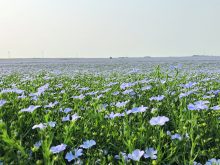Researchers at the Indian Head Agricultural Research Foundation focus on applying endophytes using a foliar spray
Canola and wheat growers in Saskatchewan want to know if a nitrogen-fixing bacteria can boost crop yields.
SaskCanola, SaskWheat and a provincial program called Agriculture Demonstration of Practices and Technologies (ADOPT) are supporting research into foliar-applied, nitrogen-fixing products.
“This is our first year of doing the trials,” said Danny Petty, executive director of the Indian Head Agricultural Research Foundation.
“It is being done across the province…. I believe all eight of our Agri-ARM (Applied Research Management) sites are doing it. We should have some good information on the results… come this fall.”
Read Also

Research looks to control flea beetles with RNAi
A Vancouver agri-tech company wants to give canola growers another weapon in the never-ending battle against flea beetles.
At the IHARF site near Indian Head, Petty and his team are testing two nitrogen-fixing bacteria products. One is Envita, marketed by Syngenta. The other is Utrisha, from Corteva Agriscience.
Corteva and Syngenta use different terms to describe the technology, but the basic concept is the same. A foliar spray of beneficial bacteria is applied to the crop. The bacteria enter the plant through the stomata, which are pores in the leaves and stems.
Once inside, the bacteria colonize the plant tissue and then fix nitrogen from the air into a form the plant can use for growth.
The technical name for such bacteria (or fungi) is endophytes. Those are described by a University of Guelph website as “microbes which inhabit plants without causing disease and may benefit their host plants.”
Syngenta, on its website, said field-scale trials in Canada have shown that crops treated with Envita had higher yields than untreated checks about 80 percent of the time.
“They (Envita and Utrisha) have been around for a few years,” Petty said. “But we’re just starting to test them out here in Western Canada.”
In the Saskatchewan trials, including the tests at Indian Head, researchers hope to evaluate how the products perform at low, medium and high rates of fertilizer.
“We have three different nitrogen rates that we’re using,” Petty said. “And within those three nitrogen rates, we have no foliar (application), then we have Envita and Utrisha.”
The results won’t be known until this fall, but farmer interest in bio-stimulants has been growing. The global market for bio-stimulants was worth US$3.5 billion in 2022 and is projected to reach $6.2 billion by 2027, says marketsandmarkets.com.
As fertilizer prices climb, many farmers want products that can help the crop access more nutrients at the lowest cost.
The trials on foliar-applied, nitrogen-fixing bacteria are one of many research projects at IHARF this summer.
The researchers are also studying re-seeding options for winter wheat, plant growth regulators, fertility rates and the impact on different barley varieties, among other things.
Petty and other IHARF staff will share information about all the trials at a crop management field day scheduled for July 18.
For more information, visit iharf.ca/indian-head-crop-management-field-day/.


















